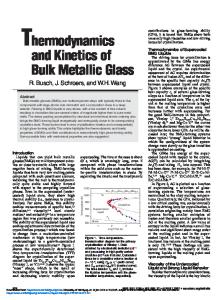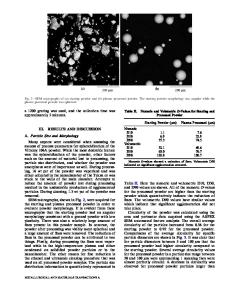Atomistic Theory of Bulk Metallic Glass Formation
- PDF / 126,416 Bytes
- 6 Pages / 612 x 792 pts (letter) Page_size
- 20 Downloads / 399 Views
CC2.5.1
Atomistic Theory of Bulk Metallic Glass Formation T. Egami Department of Materials Science and Engineering and Laboratory for Research on the Structure of Matter, University of Pennsylvania, Philadelphia, PA 19104, USA and Lujan Center for Neutron Scattering, LANSCE, Los Alamos National Laboratory, Los Alamos, NM 87545, USA ABSTRACT Bulk metallic glass can be formed only when the critical cooling rate for glass formation is reduced to 100-2 K/sec. However, a cooling rate achievable with molecular dynamics simulation is higher by many orders of magnitude, so the gap has to be abridged by analytical theories. We propose a theory of bulk metallic glass formation based upon our early theories of glass formation composition. The critical concepts include the idea of local glass transition, distributed local glass transition temperatures and coincident local fluctuation for atomic transport. Strong repulsion between small atoms was recognized for the first time as the necessary condition for bulk glass formation.
INTRODUCTION Recent development of bulk metallic glasses [1-3] has brought the field of metallic glasses back in the limelight as in the 70’s and 80’s. While metallic glasses studied in the earlier times are binary or ternary glasses, bulk metallic glasses contain many more elements. This complexity makes it even more difficult to find the scientific basis for bulk metallic glass formation, while there are a number of empirical principles. In general it is not easy to formulate a theory of glasses because of their statistical, many-body nature of the problem. It is hard even to define the structure of a glass precisely and determine it by experiment. We had earlier some success in explaining the composition limits of metallic glass formation [4]. For a binary glass, the minimum composition of a solute B in the matrix of A, cBmin, was found to be, c Bmin = 0.1
V ∆V
(1)
where ∆V = |VA - VB|, is the compositionally averaged atomic volume. Some of the reasons for the success of this approach are the following: 1. It is not based upon the comparison of the free energies. 2. We did not try to describe the structure nor state of the glass. 3. The glass (liquid) was regarded as the default state, when crystallization fails to occur. Thus we focused on the condition that a simple crystal alloy structure becomes unstable. 4. The condition was formulated purely on the geometrical basis, without any reference to electronic states nor atomic bonding.
CC2.5.2
This theory was later extended to account for the melting of a crystal, glass transition, and solidstate amorphization [5], and more recently to explain bulk metallic glass formation [6] and atomic transport in metallic glasses [7]. In the following we summarize the basic premises, recent progress and future prospects. LOCAL TOPOLOGICAL INSTABILITY The central idea of this theory is that for a given local condition there is a critical stress threshold beyond which the local structure changes its topology. Here topology is defined in terms of connectivity o
Data Loading...











